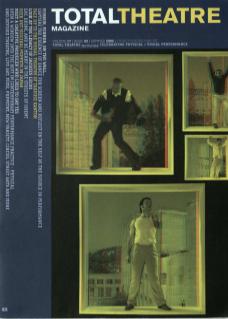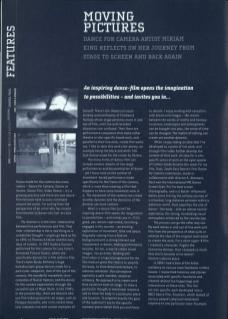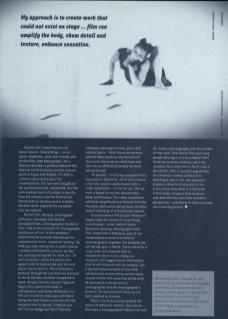Dance made for the camera has many names – Dance for Camera, Dance on Screen, Dance Film, Video Dance – it's a growing practice and there are now dance-film festivals held in every continent around the world. I'm writing from the perspective of an artist who has moved from theatre to dance into live-art and film.
My interest is in the inter-relationship between live performance and film. That inter-relationship is not a new thing as is sometimes thought – origins go back as far as 1894, to Thomas A. Edison and the early days of cinema. In 1903 Isadora Duncan performed for the camera for Loie Fuller's Animated Picture Studio, where she specifically dances for a film within a film. There's been Busby Berkeley's huge kaleidoscopic group dances made for a particular viewpoint, that of the eye of the camera; the wonderful movement story comedies of Buster Keaton; and the dance for the camera experiments through the surrealist eye of Maya Deren in the 1940s. In the present day, there are dancers who use film/video projection on stage, such as Philippe Decouflé, who in his recent show Solo interacts live with screen multiples of himself. There's the theatrical visual trickery and tomfoolery of Forkbeard Fantasy whose stage personas move in and out of film, until live and recorded characters are confused. Then there are performance companies that make either theatre or site-specific based work, and parallel to their live work, create film works too. I like to term this work cine-poetry, an example being the black and white film Sud-Grenze made for the screen by Derevo.
The many forms of dance-film can include camera reworks of live stage performances and documentation of dance – yet I focus here on the context of movement-based performance made specifically for the frame of the camera, which is more than creating a film that happens to have some movement work in it. The movement of the camera can create another dynamic, and the decisions of the director yet more content.
What is a dance film to me? An inspiring dance-film opens the imagination to possibilities – and invites you in. If it's good, you remain captivated, becoming engaged in the journey – an exciting exploration of movement, time and space. Originally coming from a fine art background with a strong interest and involvement in dance, making performance became, for me, a way to create visual images, live pictures. Working with film/video is a logical progression for me. This medium gives the chance to amplify the body, to show detail and texture, to enhance sensation. You can explore explicitly a split moment, reveal an intimacy. My approach is to create work that could not exist on stage. To show a particular thought or emotional response and to show the body in a particular place and location. To pinpoint exactly the gaze of the audience's eye to the specific moment/place/detail that you wish them to absorb. I enjoy working with sensation, with dream and images – the realms between the worlds of reality and fantasy. Locations, landscapes and atmospheres can be brought into play, the sense of time can be changed. The rhythm of editing can create yet another dynamic.
Often I enjoy taking an idea that I've developed as a piece of live work, and through film/video further develop the content of that work. An idea for a site-specific piece of work on the open spaces of Camber Sands became the seeds for my film, Dust, South East Dance's first Dance for Camera commission, made in collaboration with director A. Atanasio. Dust won the International IMZ Dance Screen Gran-Priz for best screen choreography, and is a Butoh-influenced dance piece tracing the solitary journey of a stranded, long distance swimmer within a waterless world. Dust amplifies the site of dance – the body – with an almost tactile experience; the strong, foreboding visual atmosphere enhanced by the soundscape.
The process can go the other way too. My work moves in and out of live work and film from the perspective of what suits or extends the idea of the original motivation to create the work. For a short super-8 film I created a character, Pugalo the Scarecrow Woman, that I enjoyed so much that she/it became a live dance/ theatre/cabaret piece.
My approach is to create work that could not exist on stage... film can amplify the body, show detail and texture, enhance sensation.
In 2000 I had a Year of the Artist residency at various town fountains in West Sussex. I researched histories and stories associated with specific fountains and created related live happenings and interactions at these sites. This live art/site specific work developed into a BBC2 Dance Film, Fountain, which looked at various people's physical/emotional response to one particular town-fountain.
People visit a town fountain for many reasons. Simple things – to sit alone, daydream, meet with friends, eat sandwiches, take photographs. Yet a fountain provides a gateway between the external world of reality and the internal world of hopes and dreams. It's both a common space and a place for contemplation. The live work brought out the spontaneous and unexpected, the film work enabled more of a study, a specific approach, from the ordinary into the fantastical, filmed both on location and in a studio. Yet both works explored the mundane transforming into the sublime.
My last film, Atropos, investigated pathways, footsteps and destiny, developed from a choreographic residency that I had at the Institute for Choreography and Dance in Cork. In this residency I researched the moment that follows the motivation to move. I explored 'waiting', by holding a sign stating this in public places. I waited until asked by a passer-by why I was waiting and replied 'to meet you'. On each occasion I asked the person who spoke to me to mark a map with the next place I was to wait in. There followed a pathway through the city that was dictated to me by the fate of whom I happened to meet. Atropos (an Arts Council Capture3 dance film commission made in collaboration with Simon Wilkinson) is a film set in a white landscape with black footprints that follows a journey into the moments that lie ahead. Is destiny preset? Can we dodge our fate? Imprints, pathways, passages of time, place and infinite space... What traces do we leave behind? What leads us into the future? How much choice do we really have and how are we affected by people we meet along the way?
At present, I'm writing a proposal for a new project. Specimim, which will combine a live site-specific performance with a video installation – a first for me. The live work is based on my own idiosyncratic body-architecture. The video installation will be an amplification of details from the live work, both pieces being shown at either end of a building of architectural interest.
A current dance film project Shadow of Angels takes the theme of a soul being carried away – urban realism meets Romantic painting. Working again with film-maker Simon Wilkinson, part of our collaborative process is to find our common ground together. For example, we will decide upon a theme, Simon will write a script and I will interpret that in movement/dance terms. Along our storyline I will suggest dance motivations that he will interpret with his camera. Like a devised theatre project or any other collaborative venture there can be issues around control and ownership of the work. At what point is the director a choreographer and the choreographer a director? On my work with Simon we are both credited as director.
There is much discussion around the nature of dance for camera. Does dance film need a choreographer? Editors can and do create a choreography with the rhythm of their edit. Does dance film even need people dancing in it to be a dance film? There are so many contexts, yet if the intention for a short film is for it to be a dance film, then it could be argued that this intention creates a dance film. Watching a dance film, the spectator creates a theatre of sensation in his or her mind; feels what it is like to be in that body, imagines that location, sees behind those eyes from another's perspective, and learns to take a journey into a moving picture.
Miriam King's dance-film work has been shown at Lincoln Centre, New York, Pompidou Centre/Paris, ICA, London and the Venice Biennale; in most countries in Europe and in every continent in the world (except Antarctica – but she is open to offers there!). Contact details: mim@mimking.com See www.mimking.com


